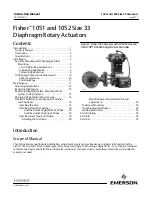
Instruction Manual
D101322X012
1051 and 1052 Size 33 Actuators
June 2017
11
Table 3. Spring for Fisher 1052 Actuator
(1)
CASING PRESSURE
INITIAL SPRING COMPRESSION
60 Degree Rotation
90 Degree Rotation
Bar
Psig
Push‐down‐to‐open
Push‐down‐to‐open
Push‐down‐to‐close
Bar
Psig
Bar
Psig
Bar
Psig
0-1.2
0-18
0.3
3.9
0.2
2.7
0.2
2.7
0.4
5.4
0.3
3.7
0.2
3
0.4
6.1
0.3
4.9
0.2
3
0‐2.3
0‐33
0.3
3.9
---
---
0.2
2.7
0.4
5.4
0.3
3.7
0.3
3.7
0.5
7.1
0.3
4.9
0.3
4.9
0.7
9.7
0.4
6.3
0.2
3
0‐2.8
0‐40
0.3
3.9
---
---
0.2
2.7
0.4
5.4
0.3
3.7
0.3
3.7
0.5
7.1
0.3
4.9
0.3
4.9
0.7
9.7
0.4
6.3
0.2
3.5
0‐3.8
0‐55
---
---
0.3
4.9
0.3
4.9
0.7
9.7
0.4
6.3
0.4
6.3
0.2‐1
3‐15
---
---
0.3
3.7
0.2
3
0.2‐2.1
3‐30
---
---
---
---
0.3
3.7
---
---
0.3
4.9
0.3
4.9
---
---
0.4
6.3
0.2
3
.
Stroking Range
Key numbers referred to in this procedure are shown in figure 10 unless otherwise specified.
If, under operating conditions, the desired stroking range cannot be achieved with the casing pressure used, it may be
possible to shift the stroking range by making a spring adjustment to change the initial spring compression. A spring
adjustment shifts the casing pressure span and equally increases (or decreases) the casing pressure at which the
actuator begins to stroke and the pressure at which the actuator reaches full travel.
To gain access to the spring adjusting screw, either the spring adjuster cover (key 117) or the switch mounting plate
(key 59) must be removed. If externally mounted switches are used, remove them as an assembly by removing the cap
screws (key 75, figure 16) and the switch mounting plate (key 1, figure 16). In order to gain access to the cap screws, it
may be necessary to loosen the hex nuts (key 77, figure 16) and slide the switches away from the actuator housing.
Note that the lower part of the spring adjusting screw (key 74) is notched so that it can be rotated with a screwdriver
or other flat bladed tool. To shift the casing pressure span downward, rotate the spring adjusting screw to the right
(see figure 5). To shift the casing pressure span upward, rotate the spring adjusting screw to the left. When the desired
stroking range has been achieved, replace the spring adjuster cover or the switch mounting plate.
Maintenance
Actuator parts are subject to normal wear and must be inspected and replaced as necessary. The frequency of
inspection and replacement depends upon the severity of service conditions. Instructions are given below for
disassembly and assembly of parts. Key numbers referenced in the following steps are shown in figure 9 for the 1051
actuator and in figure 10 for the 1052, except as listed below or otherwise specified in the procedures.












































